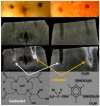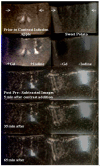Imaging of Transmetallation and Chelation Phenomena Involving Radiological Contrast Agents in Mineral-Rich Fruits
- PMID: 35645400
- PMCID: PMC9149805
- DOI: 10.3390/tomography8030114
Imaging of Transmetallation and Chelation Phenomena Involving Radiological Contrast Agents in Mineral-Rich Fruits
Abstract
Exogenous heavy metals or non-metallic waste products, for example lanthanide or iodinated contrast media for radiological procedures, may interfere with the biochemical pools in patients and in common food sources, creating an excess buildup of exogenous compounds which may reach toxic levels. Although the mechanisms are unknown, our experiments were designed to test if this toxicity can be attributed to "transmetallation" or "chelation" reactions freeing up lanthanides or chelated transition metals in acidic fruits used as phantoms representing the biologically active and mineral-rich carbohydrate matrix. The rapid breakdown of stable contrast agents have been reported at a lower pH. The interaction of such agents with native metals was examined by direct imaging of contrast infused fresh apples and sweet potatoes using low energy X-rays (40-44 kVp) and by magnetic resonance imaging at 1.5 and 3T. The stability of the exogenous agents seemed to depend on endogenous counterions and biometals in these fruits. Proton spin echo MR intensity is sensitive to paramagnetic minerals and low energy X-ray photons are sensitively absorbed by photoelectric effects in all abundant minerals and were compared before and after the infusion of radiologic contrasts. Endogenous iron and manganese are believed to accumulate due to interactions with exogenous iodine and gadolinium in and around the infusion spots. X-ray imaging had lower sensitivity (detection limit approximately 1 part in 104), while MRI sensitivity was two orders of magnitude higher (approximately 1 part in 106), but only for paramagnetic minerals like Mn and Fe in our samples. MRI evidence of such a release of metal ions from the native pool implicates transmetallation and chelation reactions that were triggered by infused contrast agents. Since Fe and Mn play significant roles in the function of metalloenzymes, our results suggest that transmetallation and chelation could be a plausible mechanism for contrast induced toxicity in vivo.
Keywords: GBCA; T1 and T2 relaxations; X-ray; chelation; contrast induced toxicity; environmental pollution; environmental toxins; gadolinium; iodinated contrast; magnetic resonance imaging; mammographic soft X-ray; radiological contrast media; transmetallation.
Conflict of interest statement
The authors declare no conflict of interest.
Figures




Similar articles
-
Lanthanide oleates: chelation, self-assembly, and exemplification of ordered nanostructured colloidal contrast agents for medical imaging.J Phys Chem B. 2009 Dec 10;113(49):15949-59. doi: 10.1021/jp906344u. J Phys Chem B. 2009. PMID: 19904961
-
Experimental and theoretical x-ray imaging performance comparison of iodine and lanthanide contrast agents.Med Phys. 1993 Jan-Feb;20(1):15-31. doi: 10.1118/1.597134. Med Phys. 1993. PMID: 8455493
-
MRI probes for sensing biologically relevant metal ions.Future Med Chem. 2010 Mar;2(3):367-84. doi: 10.4155/fmc.09.161. Future Med Chem. 2010. PMID: 21426172 Review.
-
Stability of MRI paramagnetic contrast media: a proton relaxometric protocol for transmetallation assessment.Invest Radiol. 2001 Feb;36(2):115-22. doi: 10.1097/00004424-200102000-00008. Invest Radiol. 2001. PMID: 11224760
-
Redox-activated MRI contrast agents based on lanthanide and transition metal ions.J Inorg Biochem. 2014 Apr;133:143-54. doi: 10.1016/j.jinorgbio.2014.01.016. Epub 2014 Jan 30. J Inorg Biochem. 2014. PMID: 24529651 Review.
Cited by
-
Value of contrast-enhanced MR angiography for the follow-up of treated brain arteriovenous malformations: systematic review and meta-analysis.Eur Radiol. 2023 Oct;33(10):7139-7148. doi: 10.1007/s00330-023-09714-w. Epub 2023 May 6. Eur Radiol. 2023. PMID: 37148354
-
Brain arteriovenous malformations: the long way ahead in physics, chemistry, and MR angiography practice before fully replacing digital subtraction angiography.Eur Radiol. 2023 Oct;33(10):7136-7138. doi: 10.1007/s00330-023-10063-x. Epub 2023 Aug 15. Eur Radiol. 2023. PMID: 37581665 No abstract available.
References
-
- Ebrahimi P., Barbieri M. Gadolinium as an Emerging Microcontaminant in Water Resources: Threats and Opportunities. Geosciences. 2019;9:93. doi: 10.3390/geosciences9020093. - DOI
-
- Mackowiak C.L., Grossl P.R., Cook K.L. Iodine Toxicity in a Plant-Solution System with and without Humic Acid. Plant Soil. 2005;269:141–150. doi: 10.1007/s11104-004-0401-6. - DOI
-
- Kanda T., Fukusato T., Matsuda M., Toyoda K., Oba H., Kotoku J., Haruyama T., Kitajima K., Furui S. Gadolinium-based Contrast Agent Accumulates in the Brain Even in Subjects without Severe Renal Dysfunction: Evaluation of Autopsy Brain Specimens with Inductively Coupled Plasma Mass Spectroscopy. Radiology. 2015;276:228–232. doi: 10.1148/radiol.2015142690. - DOI - PubMed
Publication types
MeSH terms
Substances
LinkOut - more resources
Full Text Sources

